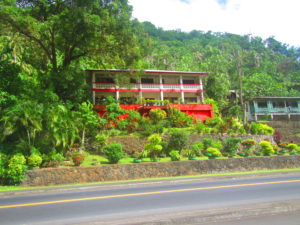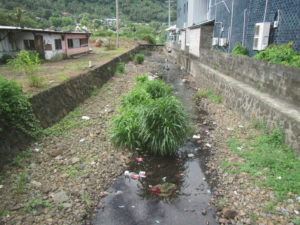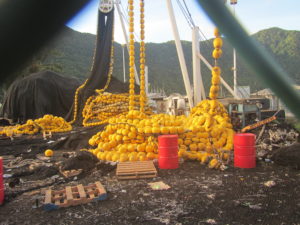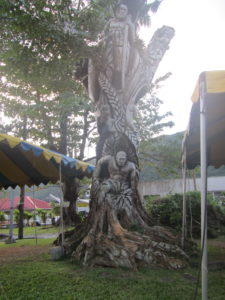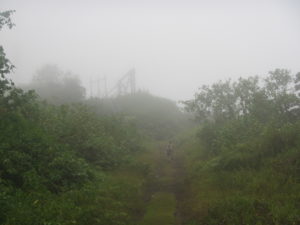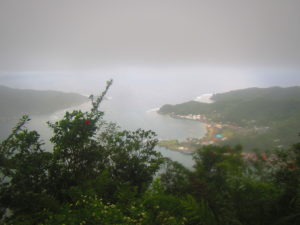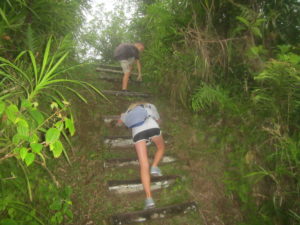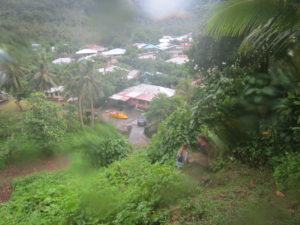Well, we had a short passage (two and a half days) to American Samoa and it was absolutely terrible. Ari, Ryan and I were very seasick, especially Ari and me. We tried not using a Scopalamine patch since we are low on them and they cause pretty significant side effects (Ari and I both get chest pressure just left of the center of our chest and some blurred vision) but the trade-off was terrible seasickness. I was miserable and Ari was too.
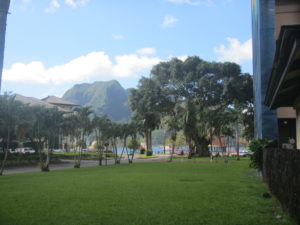
Then we finally arrived into American Samoa. Shall I start with the negatives and finish with the positives? I think I will so I can finish on a positive note! Check-in at American Samoa was terribly inefficient and was not made easier despite the fact we are also American. The harbor was remarkably dirty—absolutely disgusting—so we could not make water the whole time we were there. In fact, we had to fill jerry jugs with water from onshore to be able to shower, since we knew our tank water wouldn’t last long enough given cooking, washing dishes, etc. That meant cold showers all week. (Even when we make our own water, we only have hot showers if the starboard engine has been running that day or if we run the generator.) We also changed Lucky’s tank water in the open ocean before we got into the dirty bay. The smell in the bay was often disgusting. They have two fish canneries (one is Starkist) and the smell is nauseating downwind. A few nights I actually was awoken by the terrible smell. I will never forget how horrible that smell was!
That Bright Yellow Building is McDonald’s
The Main Street
The Beach in the Downtown Area
Another negative was the terrible holding in the bay. It was the worst holding we have come across. We held well for a little under a week, but one day after being out all day, we returned to see our boat in a completely different place, side by side with a monohull, attached to the gigantic, rusty ship mooring. That’s always a little disconcerting, to say the least. From what we understand from Paw Paw, a monohull in front of us dragged back and loosened our anchor. (They also were not on their boat.) Then we started dragging back—apparently getting closer to reef. A few guys from other boats came over, hopped onboard and started our engines. They could not pull up our anchor because we keep the compartment with the windlass control locked because we have our Parasailor in there, etc. So, these men had to power forward dragging our anchor. Apparently, our anchor then got wrapped around the monohull’s anchor, so they then dragged both of our boats a bit to get to the ship mooring, where they tied us. We were tied up next to Vasco (a Bulgarian 78 year old who was sailing around the world solo on a boat he and his late brother built). We ended up staying a few more nights on the ship mooring tied to Vasco’s boat, but when the wind got slack, we would hit the big ship mooring. Dan and Vasco were out there trying to keep us off, and we ended up bending (and breaking) our boat hook and causing slight damage to our bow above the waterline. We are going to have to get that repaired in Fiji. Bummer. In hindsight, we should have gotten off that mooring and taken our chances with our anchor again. Vasco was so nice. I made him a breakfast burrito one morning and he made us all rice pudding the next day. Dan also helped him get up his mast for a repair he needed to do and when Elaine and Roy from Paw Paw came over one evening, Vasco joined us as well for a few beers. I can’t imagine sailing alone at that age (or any age for that matter!).
A House in American Samoa
A View of the Trash: There was A LOT of Trash
The Fishing Equipment. For Some Reason, I Like This Photo
Now for the positives of American Samoa. The people were, by far, the friendliest and most helpful we have come across in our travels. It wasn’t just because we were American either; Roy and Elaine reported the same thing (and they are from Ireland/South Africa originally). Also, the provisioning was wonderful. Although I found no turkey bacon or soy sausage, we were ecstatic that we could find things that are really only available in the U.S. or that we have not seen in months. We found great canned soups, Cheeze Its, mint Oreos, Bella Vita Breakfast bars, convenience foods such as pre-made Veggie lasagna, black beans (woo hoo—it’s been MONTHS!), refried beans, bagels, fresh ravioli (but then frozen) and Amy’s Organic Frozen Burritos (for the kids). We were like kids in a candy shop.
The buses in American Samoa were fantastic and fun. They were essentially built by hand with wood on a truck frame and each driver would decorate them differently. Most drivers played common American music remade into a reggae style fairly loudly, and one driver had a huge TV where he showed Ultimate Fighting Club matches. (I preferred the music.) These buses would take you nearly anywhere you wanted to go. We took the buses to go shopping (and a cab back for our big provisioning), we took the bus to the movies (to see “The Secret Life of Pets” with the kids), we took the bus to Carl’s Junior/Green Burrito for burritos and Tropical Pizza (which was really Pizza Hut), and another day we went to the Army Reserve Center to shop at the Exchange and for an appointment to get our retiree Military Identification Cards. We were unable to update our IDs before we left because Dan was still essentially active duty (on terminal leave) up until December. So, we were pleasantly surprised when we learned American Samoa had an Army Reserve Center and they could make us our IDs by appointment. If, for some reason, we now want to take a Space A flight from Europe home, we need to have the most updated IDs to do so.
American Samoa with one of the Crazy Buses In the Background

We Could Get Our New Military IDs!
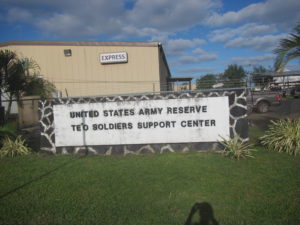
American Samoa had a McDonald’s. What’s funny is that we never eat McDonald’s for lunch or dinner at home (the kids have actually never eaten a McDonald’s hamburger), but we sometimes would get McDonald’s breakfast if we were on a road trip, etc. We eat there, on average, about 4 times a year. Well, in American Samoa, I think we ate there for breakfast five times in nine days! Crazy. Oh, and the kids also ordered a large fry to share on another day. I guess you want things more when they are scarce to you. Also, we always have that “convenience” when we are in the U.S., but almost nothing is convenient traveling out here, so I guess we just wanted to take advantage of it while we had it.
Another day, the kids and I went to the small museum they have in Pago Pago. I think it took us 30 minutes to go through the entire museum, but it was quaint and we learned a lot about the herbs they traditionally used to cure ailments (including “supernatural” ailments), we learned about their tradition of tattooing, and we saw the very small moon rocks (in acrylic) that Richard Nixon sent to American Samoa after our (America’s) moon landing. They were very tiny and maybe not so climactic but worthwhile nonetheless!
A Carving Outside the Museum
Moon Dirt or Rocks

The island of American Samoa has an amazing colony of large bats that hang in the trees across from the Port. They were very interesting to watch, especially at dusk when they became really active. We learned from a local man out for a walk that the bats settled here in this busy part of Pago Pago because they know that in that location, they are safe. We asked “from what?” and he said that even though it is illegal, the locals will shoot and eat them if they are in the less populated areas. Interesting. Bat stew?
While we were in American Samoa, we also took a bus to a trailhead in the National Park system. The hike turned out to be an interesting day. Apparently, you can either walk 3.2 miles to the summit and then come back the same way or continue the 2 miles up onto the narrow ridgeline and on to a town on the other side of the ridge. We talked to a group of locals who had just completed the hike. They went up to the first point and came back to the start and said it was a nice, tiring hike. We asked them if the bus goes to the town on the other side of the ridge, and she said they only run every two or three hours over there and they may not go that late in the day. We kept that information in our back pocket and started up the trail. About 30 minutes in, it started to pour. It never stopped! It got lighter a few times, but that rain was persistent. When we finally reached the first point, on one side of the bay we had no view at all. On the other side, we could see a portion of the view. This area at the top used to have a tram that I think the military built prior to WWII for some strategic reason. All of that was gone now, but they had a few structures still standing at this ridgeline. We ate the sandwiches we brought standing at a high worktable that had a rusty covering over it while the rain dripped down. After lunch, we asked the kids if they wanted to continue on to the town or turn back. We told them they may not have any buses over there, so we knew we might get “stuck,” but the kids wanted to continue on versus go back the same way we came. I think they were partially motivated by the fact the distance was shorter if we continued on, but that turned out to be misleading. Although it was a shorter distance, when you continue on with the hike, you spend a lot of time using ropes to go down these “ladders” and up others. We went up and down about 20-25 of these in the pouring rain. They had no room for any switchbacks in this area because we were actually traveling on the very top of the ridgeline. At some points, on either side of us, it was sheer cliff, but thankfully, the areas have very thick foliage so you knew that if you fell, you wouldn’t fall far without the dense trees and bushes stopping you. It turned out to be a very interesting hike, and the kids really enjoyed it. I was complaining (at least, on the inside), but they seemed not to care that we were soaking wet, cold, and trudging through muddy lands. I must be getting old. Anyway, we finally emerged out of the forest into a village of houses. The only person we saw was a power worker who was called out to fix something in the village on this rainy day. He looked at us like we came from the moon. He asked us if we had done the hike and when we said yes, he asked: “All the way from the other side?” We said yes, and he asked: “Wasn’t it really muddy?” We said yes once again, but I think the mud on our legs was the giveaway. When he was over his shock, we asked him if there were going to be any more buses here. It was 4:30 in the afternoon. Nope. No more buses…uh oh. But then this man called over to his friend in a pick-up truck (who literally was the only car on the road), and he asked his friend if he would drive us back to the harbor in the back of his truck and he agreed. Great luck! We jumped in the back of his truck and had the pouring rain pelting us in our faces as we traveled through the mountain roads back to Pago Pago, which was a good, solid 20-minute drive. In hindsight, it was a really good thing we caught a ride because there is no way we could have walked it and there didn’t seem to be much in the way of civilization in the village (no stores, phones, or businesses), so I am not sure we would have found a way to call a taxi to where we were. Heck, I’m not sure any of us even knew the name of the town! When we finally reached our dinghy, we were so cold and it was still pouring rain. It was so wonderful to finally get back to our boat to clean up and get warm. Overall, it turned out to be an adventurous day. We slept well.
The Very Wet Hike!
There were so Many of these to Climb (Up and Down) Because we were on a Mountain Ridge.
Some of These Were High Up and Slippery!
Finally! The Village We Were Hiking To.
Drowned Rats in the Back of a Pick-Up Truck
One of the main reasons we chose to go to American Samoa was so that we could pick up the kids’ school materials for the 2016-2017 academic year. If we had all of that stuff shipped to anywhere else, it would have cost a ton more in shipping and we would have had to pay hundreds of dollars in duty fees. Thanks to John and Stacey, we received all of our packages through regular, USPS Priority Mail. I couldn’t get a replacement battery for my Mac though. Batteries have to come via cargo ship rather than airplanes. If I knew what I know now, I would have had the company send it via ship to American Samoa back when I was in Niue (which is when I had most of the other packages sent), but I thought my brother would be able to send it more easily. You live and you learn!
We saved a lot of money on the kids’ school supplies this year. I bought several of Ari’s courses and Ryan’s curriculum on Ebay second-hand. For Ryan, we ended up getting Calvert’s 6th grade with Teaching Textbooks Pre-Algebra for Math. For Ariana, we ended up getting an Oak Meadow Biology Course, an Oak Meadow Language and Composition Course, a “Great Courses” World History set (DVDs with a Californian history/theater teacher who plays the part in his lectures, and a workbook, etc.), another World History DVD collection put out by the BBC, Teaching Textbooks for Algebra 2, and for both of the kids, I purchased Wordly Wise for their grades, and Spanish Workbooks that I will use to supplement my teaching of Spanish. Ryan finished school this year on time, but Ariana took longer. She has finished most of her work, including Geometry, but she is still finishing up her physics course (with Dan’s assistance). Two more chapters out of 20 left!
After about 9 days, it was time to leave American Samoa. We had our materials, we had re-provisioned our boat, and it was time to leave that dirty harbor. Our next passage would be a day and a half and we were headed to Niuatoputapu in the Kingdom of Tonga!



